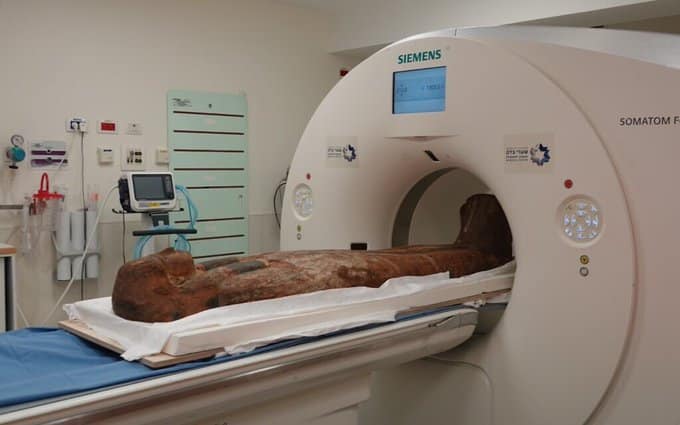A collaboration between the museum and the clinic could set a precedent for combining the study of historical artifacts with cutting-edge medical technology to better understand the past
In a meticulously planned operation that took five months to organize, two sarcophagus lids dating back more than 2,000 years from ancient Egypt were brought from the Israel Museum in Jerusalem on Friday to undergo CT scans, Israel’s TPS news agency reported.
Part of the museum’s valuable Egyptian collection, these sycamore wood sarcophagus lids were examined at the Shaare Zedek Medical Center in Jerusalem to reveal the techniques used by the craftsmen to create them thousands of years ago.
A collaboration between the museum and the clinic could set a precedent for combining the study of historical artifacts with cutting-edge medical technology to better understand the past.
Computed tomography uses multiple X-rays to create cross-sectional images of bones, organs, and blood vessels. They are commonly used to diagnose certain types of cancer, heart disease, blood clots, broken bones, disorders of the intestinal tract and spine, among other things.
“Through the scanning, we were able to identify cavities in the wood that were filled with plaster as part of the preparation for the decoration of the sarcophagi, as well as areas that were entirely cast from plaster, rather than being directly carved from the wood,” says Nir Or Lev , Curator of the Department of Egyptian Archeology at the Israel Museum.
“The research has shed light on the craftsmanship of the ancient craftsmen responsible for creating these sarcophagus lids, thereby greatly contributing to our ongoing research,” he said.
The lid of the first sarcophagus, belonging to a ceremonial singer named Lal Amon-Ra, dates to about 950 BC. On the lid are written the words “Jed-Mot”, representing the name of the deceased, along with a blessing. The lid of the second sarcophagus, dating from the period between the 7th and 4th centuries BC, once belonged to an Egyptian nobleman named Petah-Hotep.
“It’s not every day that one witnesses the confluence of glorious history and technological advancements in the field of medicine,” says Shlomi Hazan, chief radiologist in Shaare Zedek’s imaging department.
“The high-resolution scan allowed us to distinguish different materials, such as wood, plaster, as well as cavities. In addition, the cross-sectional scan revealed the tree rings, and three-dimensional reconstructions were created to help the research team analyze the composition of the different materials Hazan said.
Photo: Ancient Egyptian sarcophagi undergo CT scans at Jerusalem hospital to reveal craft / The Times of Israel@TimesofIsrael.









